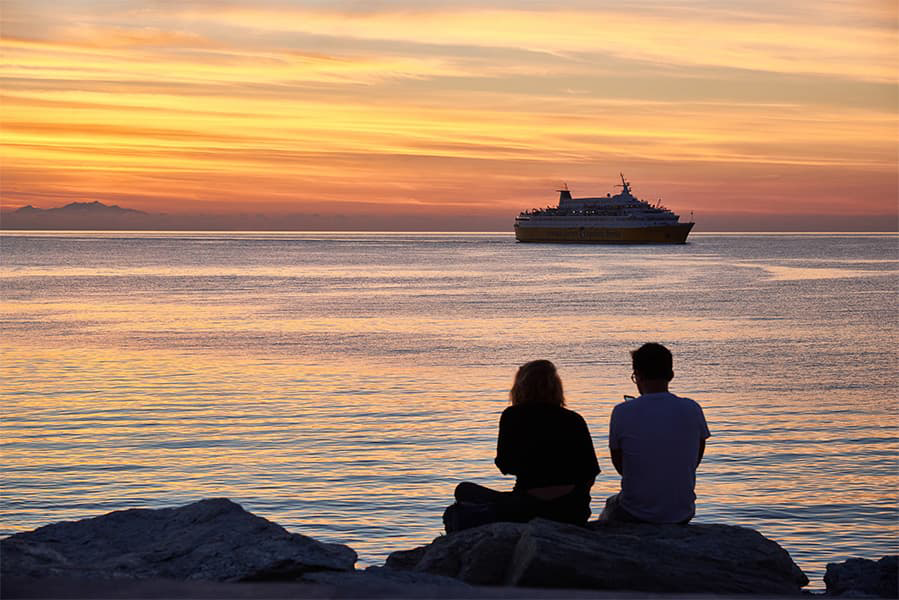Hong Kong (Sheung Wan) - Macau (Taipa)
Ferries to Macau
Hong Kong (Sheung Wan) - Macau (Taipa)
Ferries to Macau

The Hong Kong Macau ferry route connects Hong Kong with Macau and is currently operated by 2 ferry companies. The Cotai Water Jet service runs up to 148 times per week with a sailing duration of around 1 hour While the TurboJet service runs up to 17 times per week with a duration from 1 hour.
So that’s a combined 24 sailings on offer per day on the Hong Kong Macau route between Hong Kong and Macau. Compare now and get the best fare at the time that you want to travel.
More routes than anyone else.

Compare fares, times & routes in one place.
Change plans easily with flexi tickets.

Book e-tickets & manage trips in-app.
Live ship tracking & real-time updates.

Top-rated customer support when you need it.
Found on the large southern island of Hong Kong, upon the shores overlooking the deep, ultramarine waters of Victoria Harbour, is the port of Sheung Wan. This busy terminal on the north-western curve of coast is sat on an unusual H-shaped pier overshadowed by the crimson and black towers of the Shun Tak Centre. Further inland the sprawl of city skyscrapers is curtailed by the lush, rising slopes of Victoria Peak; atop which one can drink in the spectacular views across the ultra-modern cityscape. Sheung Wan lies just west of the row of Central District piers that give the coastline a distinctive saw-toothed appearance. The area, also known as the Gateway District, is famed for being the location where, in the mid-19th Century, the British entered Hong Kong in their successful attempt to merge the region into its ever-expanding empire. The British influence is still strong in Sheung Wan. The red-bricked Western Market, a shopping complex ranked among the country’s oldest structures, is built in a distinctive Edwardian style, while local roads possess anglicised names; among them Castle Road and Wellington Street. The ferry terminal itself is blessed with plenty of passenger facilities. Aside from the helipads upon the roof, the multi-levelled building is home to a variety of shops, cafes and restaurants selling hot food and drink, a streamlined check-in terminal, and a nearby ATM machine. A taxi rank and bus station can be found directly outside the port too. The port of Sheung Wan is fed by a multitude of transport links, a consequence of its prime central location. The sweeping Connaught Road Central, a route that spans the entire northern coastline of Hong Kong Island’s city district, can be found directly outside the ferry terminal entrance. Mini buses regularly travel along this route, heading to a host of destinations on the island as well as across the bridge to the Kowloon District. Ferries leave from the harbour multiple times throughout the day. Fast services hosted by TurboJet and Cotai Water Jet head west to the Asian region of Macau and the ports of Macau Outer Harbour and Macau Taipa; these routes whisking passengers on a snaking route through an island-studded expanse of the South China Sea.
Macau borders the city of Zhuhai, on the south east coast of China. The port serves passengers with ferry routes to other areas of China, though predominantly it is used to transport passengers to Hong Kong. There are around 77 crossings per day to Hong Kong, typically lasting just under an hour. With a population of just over 650,000 living in an area of 30.5 km2, Macau lies in the most densely populated region in the world. Macau has recently been dubbed as the ‘Las Vegas of China’ due to the abundance of extravagant casinos making it a haven of gambling and glamour. It differs, however, from Las Vegas in its class and diversity; being a Portuguese colony for several hundred years, there is a mix of Asian and Western European culture that is unique to the city. Away from the casinos and restaurants, plenty of history can be enjoyed around the city. St Paul’s ruins are a must-see whilst in the area, especially for a change of scenery from the tall buildings and buzzing streets. For an even greater change in landscape, head to Old Taipa Village for a chance to spend time with the local people and learn about their traditional faith and values. Macau is dense enough that the majority of the major attractions are found in the city centre, therefore are generally within walking distance of each other. For transport to the ferry terminal, there is a bus service that stops directly outside the port, though the lack of English spoken can make it hard for visitors to negotiate with the driver. It may be best advised for tourists to get a taxi on their first visit.